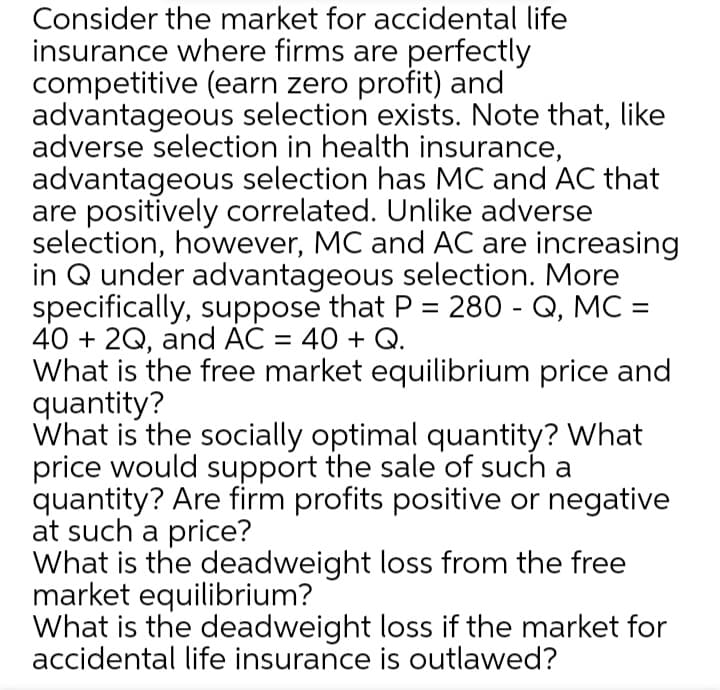Consider the market for accidental life insurance where firms are perfectly competitive (earn zero profit) and advantageous selection exists. Note that, like adverse selection in health insurance, advantageous selection has MC and AC that are positively correlated. Unlike adverse selection, however, MC and AC are increasing in Q under advantageous selection. More specifically, suppose that P = 280 - Q, MC = 40 + 2Q, and AČ = 40 + Q. What is the free market equilibrium price and quantity? What is the socially optimal quantity? What price would support the sale of such a quantity? Are firm profits positive or negative at such a price? What is the deadweight loss from the free market equilibrium? What is the deadweight loss if the market for accidental life insurance is outlawed?
Consider the market for accidental life insurance where firms are perfectly competitive (earn zero profit) and advantageous selection exists. Note that, like adverse selection in health insurance, advantageous selection has MC and AC that are positively correlated. Unlike adverse selection, however, MC and AC are increasing in Q under advantageous selection. More specifically, suppose that P = 280 - Q, MC = 40 + 2Q, and AČ = 40 + Q. What is the free market equilibrium price and quantity? What is the socially optimal quantity? What price would support the sale of such a quantity? Are firm profits positive or negative at such a price? What is the deadweight loss from the free market equilibrium? What is the deadweight loss if the market for accidental life insurance is outlawed?
Chapter7: Uncertainty
Section: Chapter Questions
Problem 7.4P
Related questions
Question

Transcribed Image Text:Consider the market for accidental life
insurance where firms are perfectly
competitive (earn zero profit) and
advantageous selection exists. Note that, like
adverse selection in health insurance,
advantageous selection has MC and AC that
are positively correlated. Unlike adverse
selection, however, MC and AC are increasing
in Q under advantageous selection. More
specifically, suppose that P = 280 - Q, MC =
40 + 2Q, and AC = 40 + Q.
What is the free market equilibrium price and
quantity?
What is the socially optimal quantity? What
price would support the sale of such a
quantity? Are firm profits positive or negative
at such a price?
What is the deadweight loss from the free
market equilibrium?
What is the deadweight loss if the market for
accidental life insurance is outlawed?
Expert Solution
This question has been solved!
Explore an expertly crafted, step-by-step solution for a thorough understanding of key concepts.
Step by step
Solved in 3 steps with 1 images

Knowledge Booster
Learn more about
Need a deep-dive on the concept behind this application? Look no further. Learn more about this topic, economics and related others by exploring similar questions and additional content below.Recommended textbooks for you



Exploring Economics
Economics
ISBN:
9781544336329
Author:
Robert L. Sexton
Publisher:
SAGE Publications, Inc



Exploring Economics
Economics
ISBN:
9781544336329
Author:
Robert L. Sexton
Publisher:
SAGE Publications, Inc